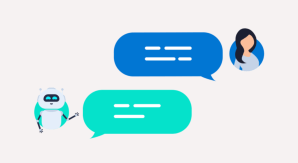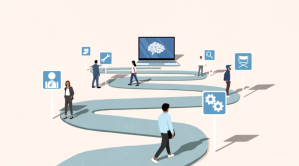As it informs more business decisions and transforms your relationships with customers, leaders must understand its potential, its use cases, and its risks. Start by asking the right questions.
Are you overwhelmed by generative AI yet?
The questions about AI businesses need to ask themselves – about technology, skills, privacy, data, and organisational requirements, to name a few – are endless. It can be hard to know where to begin, and the most pertinent AI questions to ask, before diving in.
“For a lot of our customers, this is about getting going for the very first time with AI,” said Marc Benioff, CEO of Salesforce. “They may have been using predictive AI, machine learning or even deep learning. Now they’re exploring this next generation of AI to understand how they’re going to take productivity to the next level.”
Demand and potential are both great. But so are the risks. We’re here to help.
The employee view
- 56% of workers in a recent survey said they believe generative AI (gen AI) will transform their roles.
- 65% believe gen AI will allow them to focus on more strategic work.
- Workers believe generative AI will save five hours a week.
The exec summary
- Gen AI will add up to $4.4 trillion to the global economy annually.
- 75% of the potential value from gen AI is concentrated in four functions: customer operations, marketing and sales, software engineering, and R&D.
- Gen AI, with other automation technologies, could add up to 3.3 percentage points annually to productivity growth, but companies will need to support employees along the way.
Everything you need to know about AI
Our AI Hub is filled with content to help you understand AI better. Glossaries, customer stories, use cases, how-to’s, and more, it’s all here.



Your next move
- Ensure your AI technology meets company guidelines and industry regulations.
- Develop a strategic plan with specific use cases.
- Ask the right questions about AI, starting with…
How good is our data?
Generative AI promises to significantly reshape how you manage your customer relationships, but it requires data that is accurate, updated, accessible, and complete. Why is this important? You may do something differently this quarter than you did last quarter, based on the latest data. But if your data is outdated or incorrect, that’s what the AI will use.
When training your models for generative AI, you should first ensure data excellence from top to bottom. To get your data house in order, remove duplicates, outliers, errors, and other things that can negatively affect how you make decisions. Then connect your data sources — marketing, sales, service, commerce – into a single record, updated in real-time, so the AI can make the best recommendations.
McKinsey recently wrote, “Companies that have not yet found ways to harmonise and provide ready access to their data will be unable to unlock much of generative AI’s potentially transformative power.”
How do we establish trust?
Trust – that you will protect customer data and use AI ethically – is at the heart of how widely and successfully businesses and customers will embrace generative AI.
Ask yourself, is your technology partner building AI safeguards into the fabric of their systems and apps? Large language models (LLMs), the computer programs upon which AI algorithms are based, contain huge amounts of data but they lack safeguards, controls and privacy features. Companies can leverage AI’s productivity gains without giving away data.
Trust in AI data privacy requires special safeguards including data masking, toxicity detection, data grounding, zero retention, and more. These guardrails protect data and help ensure ethical use, boosting the chances of AI success.
Do we need to reorganise our company around AI?
Research featured in Harvard Business Review found that AI initiatives face formidable cultural and organisational barriers and that companies need to align their culture, structure, and ways of working to support and scale AI. Ask yourself, do all your stakeholders share that responsibility?
Generative AI is such a game changer that some companies are establishing cross-functional AI task forces to determine how to proceed. Experts suggest establishing an AI governance committee to, among other things, guide development teams and set standards for explainability. That is, determining how and why AI makes the recommendations it does.
Schneider Electric, for one, has formalised an AI program under a chief AI officer and scaled it to every corner of the company. It implemented a global hub-and-spoke AI operating model. Each business function “spoke” (marketing, sales, service, etc.) has an AI product owner and change agent who works with the tech competency centre “hub” to find new uses for AI, deliver the technology, and ensure employee adoption.
“Every use case — and we have AI use cases in almost every function — has people from both the AI Hub and business,” said Madhu Hosadurga, global vice president of enterprise AI at Schneider.
Do we have the right skills?
AI is evolving at such a furious pace, that the answer to this question (for most companies) is probably no. A recent survey found that 67% of global business leaders are considering using generative AI, but roughly the same number of IT leaders say their employees don’t have the skills to use it.
Being an AI-first company (like being digital-first or mobile-first before) requires a close evaluation of your talent. First, you need to determine your current capabilities relative to what you want to accomplish. Identify the gaps, then prioritise building those AI skills. Of course, these will vary by your company’s industry and specific needs.
You will likely have to develop a hiring plan to acquire talent, and train workers to use generative AI. You can do the latter by providing access to on-demand learning for critical skills, incentivizing workers to learn new skills and prioritising upskilling as part of the job.
“Change management starts with people,” said Clara Shih, CEO of AI at Salesforce. “It’s going to take all of us to reskill and learn about these new capabilities.”
What gen AI terms do I need to know to carry on a conversation?
You don’t need to be a software engineer or data scientist to understand gen AI or speak with authority about it with technical people. But business leaders should be able to think about AI holistically, including benefits and risks, where it fits into the company’s culture, and mission, and what type of governance and infrastructure it requires.
Business leaders can’t help lead AI programs to success if they can’t engage with the tech teams.
We’ve put together a list of the most essential AI terms that will help everyone in your company — no matter their technical background – understand the power of generative AI. Each term is defined based on how it impacts both your customers and your team, a crucial element in understanding the power of AI.
Gen AI technologies (and adoption) are growing extraordinarily fast. As it informs more business decisions and transforms your relationships with customers, leaders at all levels must understand its potential, its use cases, and its risks. How do you do that? Start by asking the right questions about AI.
Get started with artificial intelligence
There’s a lot to know about AI. This learning trail covers the basics of gen AI, natural language processing basics, and much more.

























